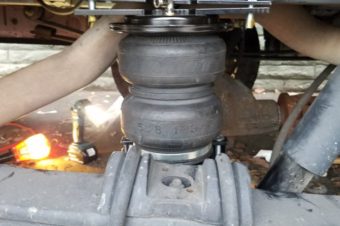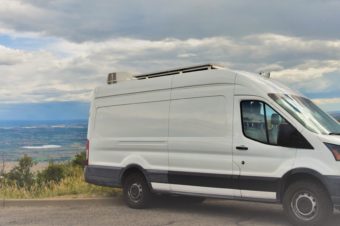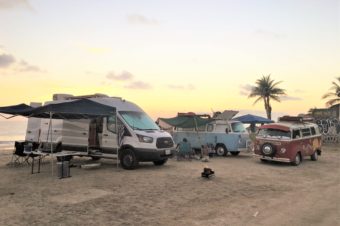Paradise is chillin’ at the beach in the comfort of your own home, right? Since I’m writing this article doing exactly that, I have to say: Yes. Yes indeed, it is.
But what these Instagram photos don’t show you is sand in every crevice of your van, feeling sticky five minutes after you showered, and the various effects of humidity on your home, your food, your bed, etc.
In this article, I share with you some tips and tricks of vanlife on the beach in Mexico. This article is specific to Mexico, but much of it can be applied to any hot and humid beach.
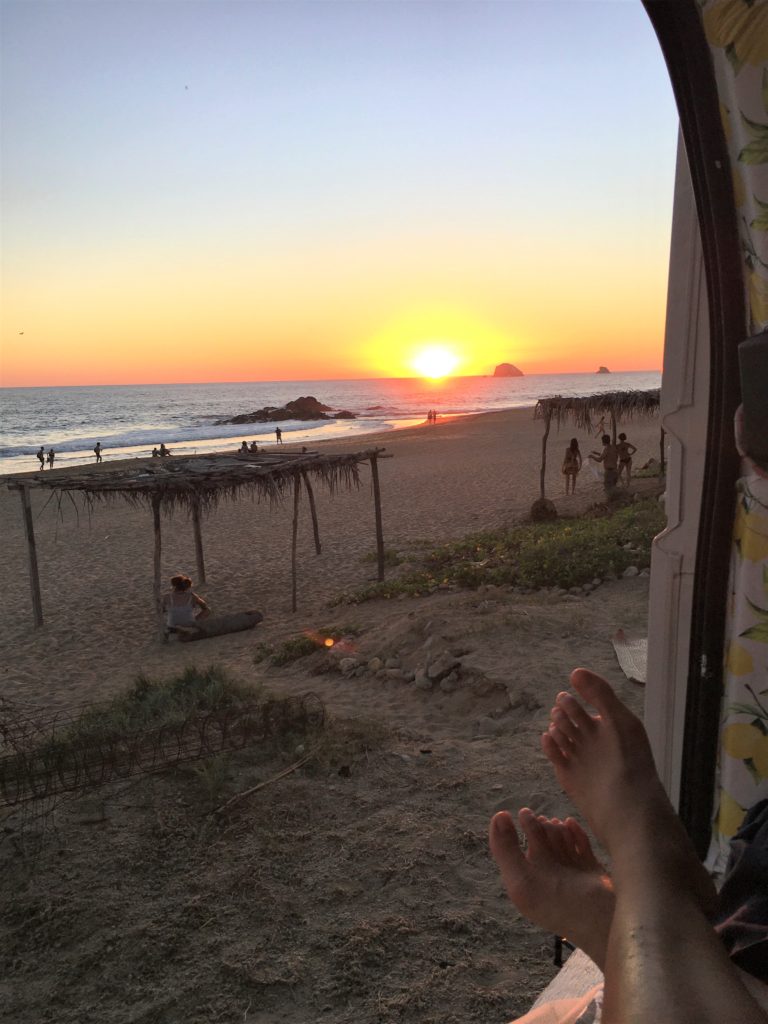
Check out my article on Vanlife at Playa Zipolite, our favorite beach boondocking spot in all of Mexico!
DangGoodLife Note: If you’re unfamiliar with vanlife and our DangGoodLife story, here’s the short version: My husband, dog, and I have been driving through Mexico in our 2015 Ford Transit high-roof van (Alevander the Great). We converted this van into our casa rodante (rolling home) with our own two hands, so it has everything we need to live comfortably on the road. We share our travels through DangGoodLife to help others plan their overland journeys through Mexico.
1. Get a Bucket – or Several
Buckets are super handy. Here are some of the ways that we use buckets while overlanding on the beach:
As a foot wash – The best way to keep sand out of the van is to put a foot wash outside the door. Step into your foot wash, shake off the excess water, then dry your feet on a rag or rug inside the van. Our foot wash bucket is a rectangular, under-the-bed storage bin. It’s usually stuffed into our garage, housing miscellanea, but at the beach, it’s our foot wash. Replace the water as needed.
To catch rainfall – Freshwater is a precious commodity at the beach. Leave containers out to catch rainfall. I don’t recommend drinking it, but you can use it to shower, rinse out your clothes (see the next section on laundry), wet your bandana, clean house, etc. Our neighbors even showered in the rain, and I’m just jealous we didn’t think of that too!
To do laundry – To launder our rags, I use a bucket and biodegradable soap. I rinse the rags first in several buckets of seawater, then wash them with a mix of seawater and detergent. Finally, I rinse them with freshwater and hang to dry. It’s not perfect, but better than nothing!
As a toilet – We have a portable toilet, so we personally don’t use a bucket for this, but we know other overland travelers who do. They fill up the toilet with sand from the beach, and do their business in the bucket, dumping as needed. I don’t think this works well for going #2, but again we don’t have personal experience on this.
As a pet bath – I also use our rectangular foot wash bin to bathe our dog. It keeps him off the sand so the shower doesn’t end with him standing in a puddle of mud. I use the solar shower (laying at table-height) and watered-down dog shampoo. I find this makes it easier to create suds, it doesn’t waste so much shampoo, and you don’t need as much water for rinsing off. Clean dog, cool dog, happy you!
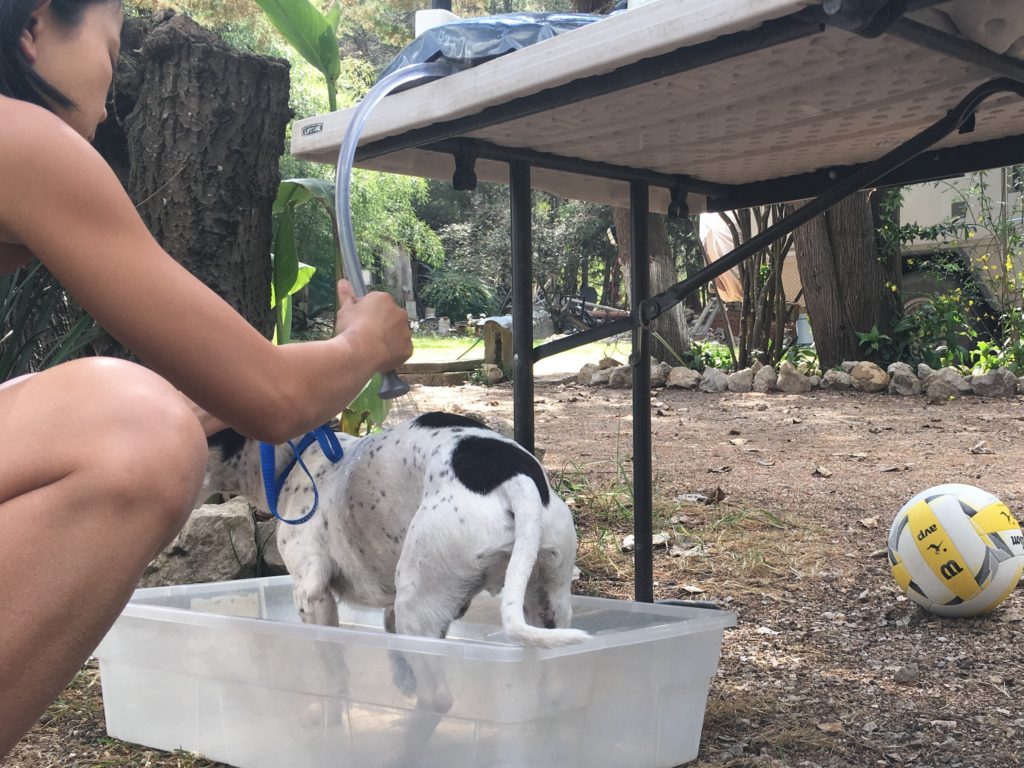
DangGoodLife Pro Tip: Get a collapsible bucket, like this one, for easier storage. You can also repurpose your plastic storage bins to serve the same purpose as a bucket. In vanlife, everything needs to be multi-purpose!
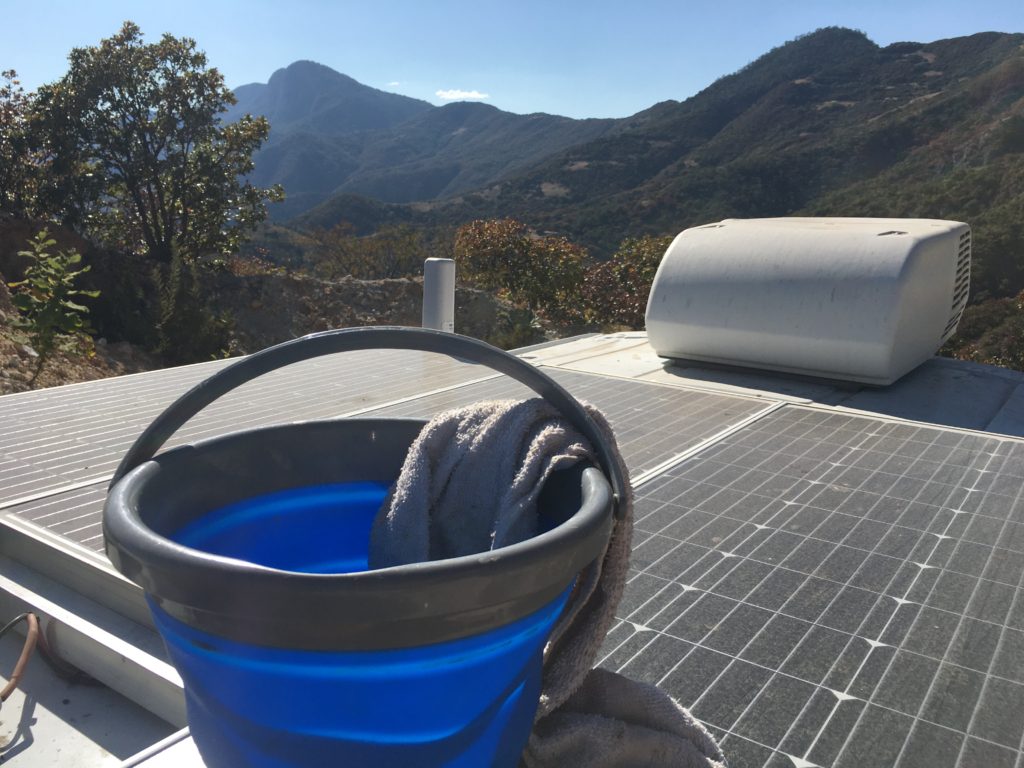
2. Get a Large Mat
In Mexico, you’ll find large mats woven out of dried weeds. We bought ours from a beach vendor for 150 MXN. They’re biodegradable, don’t get too hot, and roll up easily. A picnic blanket works too, but you may need to anchor it down from blowing away in the wind.
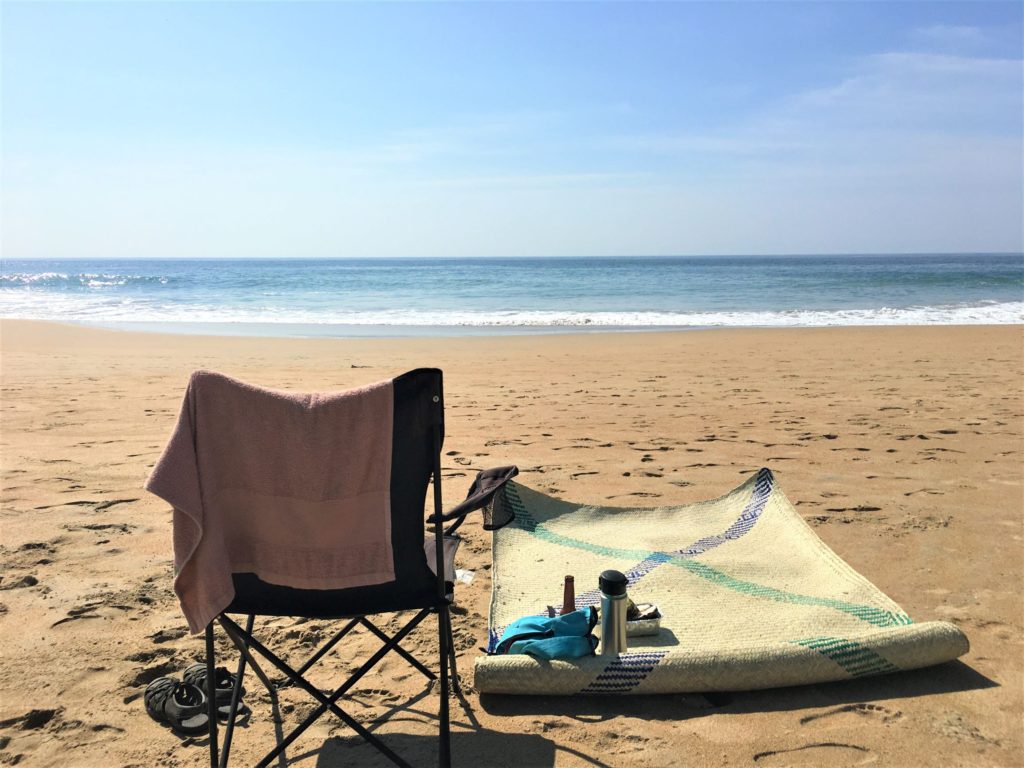
Here are some uses of a large mat, or several, while overlanding at the beach:
As a picnic or sunbathing mat – Laying out on your towel is so last century! Avoid getting your fabrics (clothing, towel, etc.) too sandy on the beach by using a mat instead. Mats “woosh” better than towels and don’t get so dirty so quickly. Plus, you save a towel for other purposes.
As a patio outside the van – You just need to step outside for a little bit, but now you have sand on your feet again! Prevent this with a mat outside your door – voila! You now have a little patio, an extension of your home.
To avoid sand bugs – Create a barrier between your feet and the bugs in the sand. Ants bite, and it’s annoying and painful. Having a mat to stand on or to rest your feet on helps with keeping the bugs away.
3. Pack Rope – Lots of It
Rope, or heavy string, is useful for many things at the beach:
As a clothesline – Living at the beach is a constant cycle of wet and dry. Use rope as a clothesline so you can hang things in the sun regardless of where the sun is shining.
For a makeshift shade structure – All you need is a tarp, ropes, and something to attach to, to create a bit of shade. With rope, you can tie your tarp (or fabric) to your car, trees, or someone else’s canopy.
For security at night – When it’s too hot at night, we crack our van rear doors open to let in the fresh air, since we don’t have any windows in our living space. To prevent anyone from opening our doors while we sleep, we use a sturdy rope (in this case, Willie’s rope leash) to tie the doors together, just enough that you can’t open the door more than a couple inches. (For our set up, we installed a set of sturdy hooks on each door, and we tie the rope around these hooks.)
4. Get a Solar Shower and a Portable Toilet
To be as self-sufficient as possible, get a solar shower like this one, far sturdier than the others! We attach it to our expandable ladder or the hooks on our rear doors, depending on how much effort we want to put into setting up our shower. You can stand inside a bucket/bin or on a stool/chair to avoid sand splashing back up on your clean legs.
A portable toilet (we have this one) is very handy. You can empty your portable toilet into any sewer port or flushing toilet, so paying for an RV hookup is unnecessary (they’re rarer to find and more expensive). Be sure to pack some toilet tabs and bleach too, to reduce the smells.
5. Use Non-Fitted Bed Sheets
We usually sleep on a fitted bed sheet, but at the beach, we use non-fitted sheets. They’re much easier to remove and ‘whoosh’ outside, which we do a couple times a day (we’d like to blame our dog, but it’s not just him).
Who wants to remove and repeatedly reattach fitted sheets?!
6. Pack a Rake and/or a Shovel
If you camp in an area with lots of fallen leaves or plant matter, it’s in your best interest to rake this dried, dead stuff away before you set up camp. Ants and even scorpions can live in it, insects which you don’t want camping beside you.
A shovel is useful for many reasons: digging holes, building camp, moving stuff, etc. We have a small folding shovel, which takes less space in our van’s garage.
7. Sunscreen, Bug Spray, Anti-Itch
This is my trifecta of essentials for beach living.
Sunscreen: I hope this is a Captain Obvious for you, but sunscreen is essential. The sun is stronger closer to the equator and, chances are, you’re in the sun all day. Even if you’re hiding under an umbrella or a canopy, or wearing a full suit of clothing, these fabrics are not UV-proof. You still need sunscreen. Do not ruin your vacation with a painful (and embarrassing) sunburn. Sunscreen is sold in most convenience stores.
If you’re going anywhere with coral reefs (like the Yucatán) please, please, use this sunscreen. Mainstream sunscreens include chemicals that contribute to coral bleaching. Even the sunscreens that say they are coral-safe are not actually coral safe! This false advertising must be one of my biggest pet peeves because well-meaning travelers are unknowingly contributing to coral bleaching. You must check the ingredients list for oxybenzone, octinoxate, octocrylene, homosalate, and octisalate.
Bug Spray: Mosquitos come out around sunset. If you’re susceptible to bites, bring bug spray. After intense research on the most effective bug sprays, my favorite is this Off! Bug Spray. It is very effective and does not leave the skin greasy. Wash your hands after use.
You can also spray your clothing, as fabric holds on better than your skin. If it’s really bad, try this spray. It’s important to follow the application instructions for this very potent solution.
Anti-Itch Creams: I’m always amazed when travelers susceptible to itching do not carry along hydrocortisone anti-itch cream. Itchy bug bites drive me crazy! Scratching often makes the itch worse, and you can get an infection if you break the skin.
I recommend over-the-counter hydrocortisone cream and After Bite.
8. Attach Mesh on Your Doors and/or Windows
The ocean breeze works wonders to cool your living space, but with the breeze also comes bugs – mosquitos, wasps, bees, flies, ugh! The solution? Attach mesh fabrics to your doors and/or windows. I made our mesh curtains using leftover tulle from my DIY wedding dress.
Depending on your van set up, you can use large magnets or Velcro to hold up the mesh. If using Velcro, attach the plastic bristled side on the van. Attach the soft side to the mesh. This helps to prevent rips in the mesh since the plastic Velcro side can get stuck in the fabric when you roll it up for storage. When cutting to size, veer on the side of extra mesh, since the wind will push and pull, and you want that extra coverage. You can attach weights (such as pebbles) to the bottom as well.
We’ve found that using mesh also “catches” the ocean spray on windy nights, preventing salty seawater from landing on your bed or living area. Bonus!
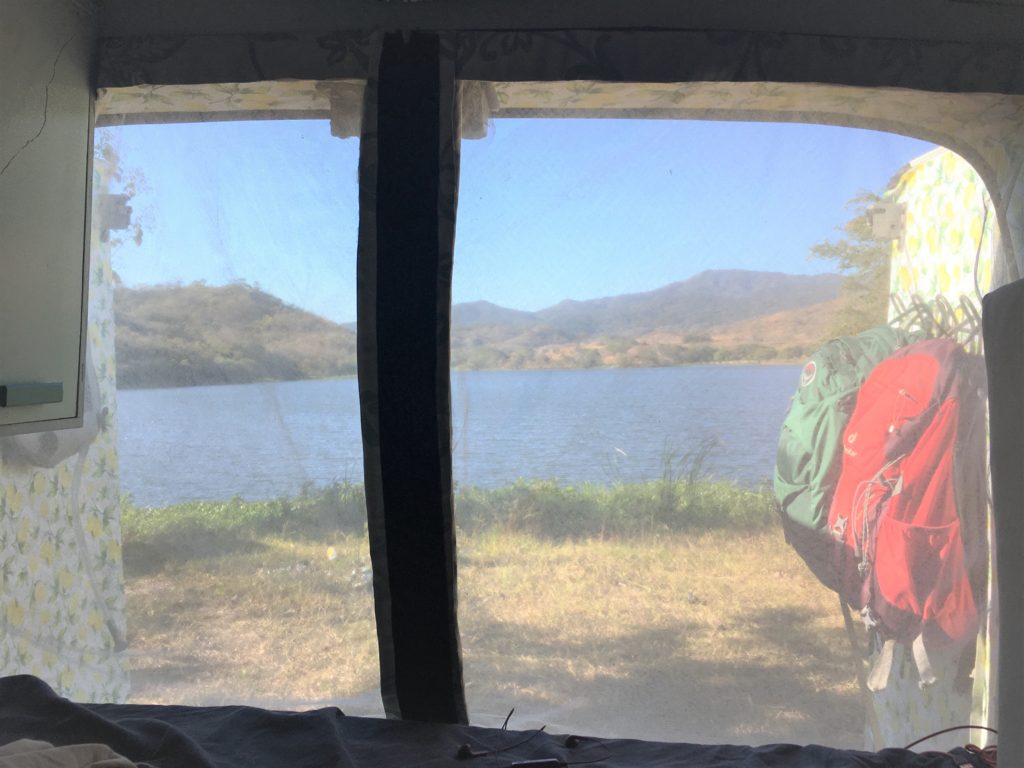
9. Prevent Food Spoilage
In hot, humid areas like most Mexican beaches, your food will spoil much faster. Things you normally wouldn’t refrigerate, like oranges and grapefruits, will spoil in the heat. Here are some ways to prevent it:
Get a fridge or cooler – While a 12-volt compressor fridge (we have this Costway fridge) is the most energy-efficient option, anything is better than nothing. If you do have an electric fridge, be prepared for a much higher draw than normal. The fridge needs to work overtime in hot temperatures.
To decrease the power draw and keep your fridge cooler, you can:
Add a bag of ice. By adding ice, the fridge doesn’t have to use quite as much power to maintain the temperature. And, since we have ice, we don’t need to refrigerate our water bottles. Double bag the ice to reduce the impact of ice melt in the fridge.
Pack more stuff in the fridge/cooler. It’s more energy-efficient to have more stuff in the fridge, rather than less. Once cold, each refrigerated item helps ‘store’ the cold. When in doubt, refrigerate!
Use a produce wash – It’s always recommended to use a produce wash or produce soak when consuming raw foods in Mexico. This is especially true at the beach. We use Citro, which is made of grapefruit extract. It’s all-natural, organic and biodegradable, so you don’t need to rinse your vegetables after soaking. You can usually find it at health food stores in Mexico. (I couldn’t find Citro on Amazon or even through Google search, but a popular alternative that I haven’t yet tried is Veggie Wash). The more common type you’ll encounter in convenient stores is Microdyn. It works the same way, but it’s best to rinse off the chemicals before eating.
10. Take your Bathing Suit Off Outdoors
Sand gets everywhere. I’m sure it’s happened to you: you pull your bathing suit down and out plops sand that you didn’t even know was there. Take off your suit outside, or at the very least while standing on a mat or towel.
11. Look Before you Park
It’s so easy to get excited about a spot and park immediately. But, unless you have 4-wheel drive, please look before you park! Some spots can have super soft sand. We’ve seen people get stuck for hours!
If you do get stuck, the longer you stay, the more you sink. It’s best to deal with it immediately. We packed traction boards, but haven’t had to use them yet (knock on wood).
12. Humidity-Proof your Van
If possible, humidity-proof your van. You can do it several ways:
Mold-Resistant Paint Finish: Because I knew we would be traveling to humid areas, during our DIY van build I painted every piece of wood in at least three layers: primer, color, and water-based poly finish. Adding a semi-glossy poly finish makes surfaces easier to clean and more resistant to humidity when your wood can get moist and mold without proper ventilation.
Ventilation: Air circulation is very important in vanlife, not just on the beach but all the time. It cools the van and helps to prevent moistness, which can lead to mold. In Alevander, we installed a MaxxAir roof vent, we have two 6” diameter 12-volt fans, and we installed lots of polyiso foam board insulation. We also leave the doors open with mesh screens up (see tip #8), which gives us a nice wind tunnel effect. People always comment on how much cooler our van is inside.
Regarding the MaxxAir roof vent, this particular model has extract mode and intake mode. We rarely use the intake mode, because it just doesn’t seem as effective. Instead, the extract mode pulls fresh air in (especially with the doors or windows open) and sends out the hot air generated by our bodies and the compressor fridge. Heat rises, and the vent helps that along.
Give your Electronics Room to Vent: For us, our three AGM batteries and our entire electrical system are housed in a DIY bench with liftable lid. Our compressor fridge lives inside of another bench. Though both benches have holes and enough room to circulate air, the heat and humidity at the beach requires extra measures.
For the battery/electronics bench, we leave the lid raised and point one of our fans on the batteries during the hottest parts of the day. We’ve found this helps increase our solar charging rate.
For the compressor fridge bench, I ended up whipping out my jigsaw right on the beach and cutting out a much larger hole for better ventilation. We also leave the lid raised 24/7. Compressor fridges, especially, need to ventilate, or condensation will form as the fridge sweats.

13. Take Special Care with Electronics
Be extra careful with your electronics on the beach! Sand and salt can do lots of damage. Phones, kindles, laptops, cameras, etc. are all very sensitive, not only to sand but also to ocean spray. Either be super-duper careful or leave them in the van.
Keep sandy items like towels, clothes, shoes, and food in a completely separate bag. Even storing your electronics in a Ziploc is better than nothing. We put our most important items in a Ziploc and then in a dry bag.
14. Use Rust-Proof Metals
We learned this lesson from the metal parts of our dog’s collar and leash after they started rusting from our walks on the beach and the constant sea spray. Our dog had orange rust stains on his neck for a week! We ended up duct-taping the metal parts of his collar, a temporary solution until we could get a new stainless-steel collar.
If this has already happened to you, you can remove rust stains by rubbing lemon or lime juice into the fur. Let sit for ten minutes before washing it out.
15. Cleaning: Bleach, Vacuum, Incense
Bleach: It’s stinky but magical. Again, with the heat and humidity, everything just smells more. We pour a little bit of bleach gel down the sink drain after every grey water dump. We also pour bleach gel down the toilet bowl of our portable toilet whenever the smell gets too much (yes, even after adding a toilet tab). And we’ve used bleach to clean counters and walls since it helps to kill bacteria.
Vacuums: If you want to get serious about cleaning, get a small vacuum. We have this model, but they don’t make filters for them anymore, so I can’t recommend it. If you have the power supply for it, using a vacuum is an absolutely cathartic experience at the beach. That mess of sand that you can’t reach? Presto-change-o… gone! I love it.
Incense: We use incense a lot in vanlife. We light it most when using our portable toilet. The smoke also discourages mosquitos and masks leftover cooking smells.
There are also mosquito-repelling incense coils, but these should only be used outdoors, if at all. There are many studies on the cancerous effects of these coils, so please read up before you decide to purchase. We do not use them (we use this Off! bug spray instead).
16. Charging Up Your Batteries
Despite 500 watts of solar panels and three AGM batteries, we can still run low on power. Sometimes, solar power just isn’t enough to offset the fridge (working on overdrive to keep a low temperature), two 12-volt fans running all day, and electronics like our pressure cooker, kettle, and vacuum.
For example, in January, our solar panels could only recharge our batteries at a maximum of 12 amps. By running our van, we can charge at up to 100 amps!
We only run the van when we’re desperate since it wastes gas, isn’t great for the engine, and pollutes the air. (We do meet California’s low emissions standards though, so we emit significantly less than most vehicles we encounter in Mexico.)
But when idling the van, the biggest danger is carbon monoxide poisoning. Carbon monoxide is the most dangerous of vehicle emissions – potentially life-threatening.
So, if you’re set up to charge your batteries with the car’s alternator, we recommend checking where your vehicle’s exhaust pipe extends. If the pipe extends all the way behind the van, you’re golden. If it doesn’t, you may want to get your exhaust pipe extended.
Check out our article Vanlife: Why You May Need to Extend Your Vehicle Exhaust.
I hope this helps you to prepare for VanLife on the beach in Mexico!
If you have any questions or comments, feel free to contact us at hello@DangGoodLife.com.
If this article has helped you to plan your own adventure in Mexico, please consider supporting us by shopping through our affiliate links, sharing this post, and engaging with us on our social media channels. Your support helps us keep gas in the van so that we can continue to provide this Dang Good content.
With sincere gratitude,
Lien & Jon

